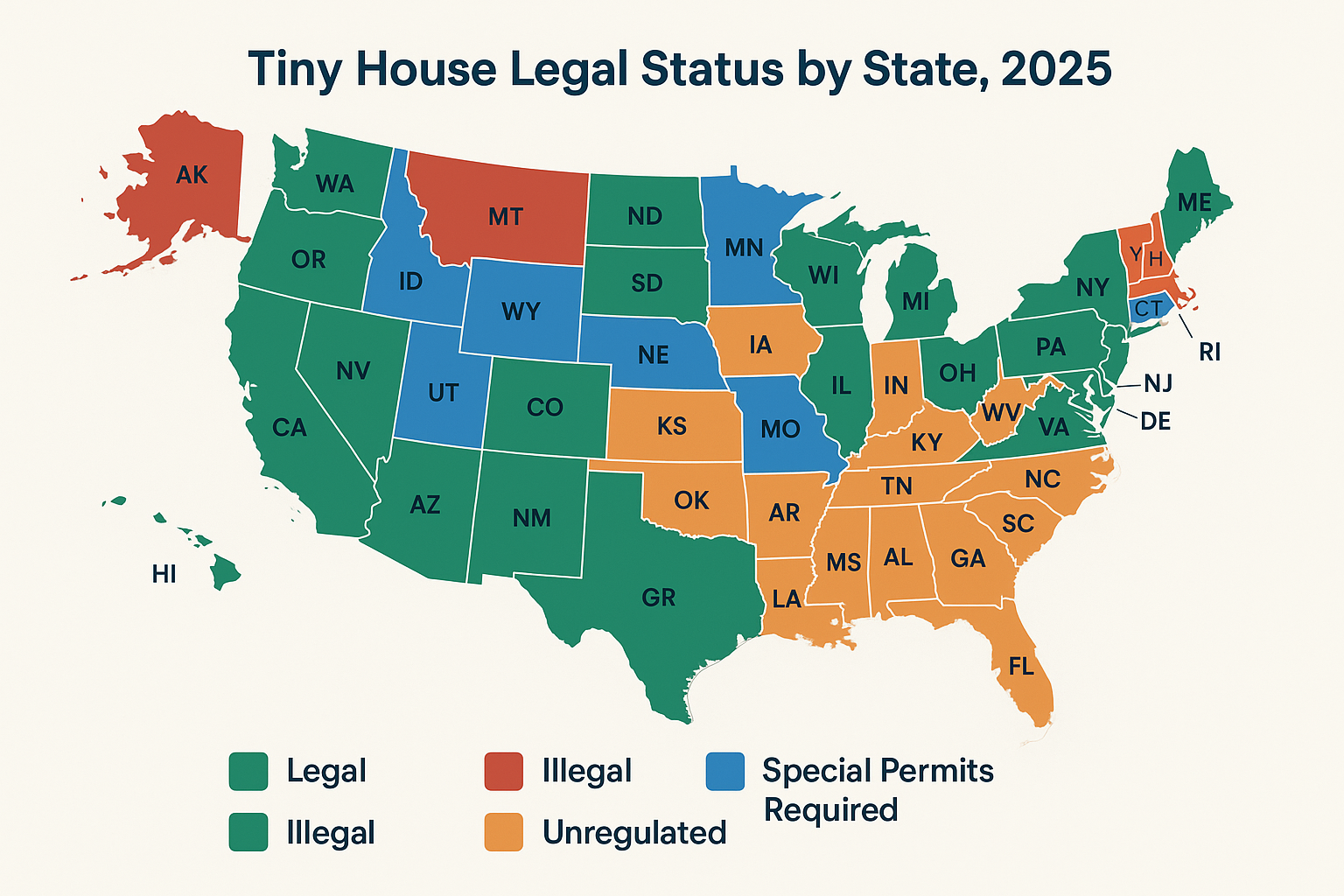The tiny house movement has revolutionized how Americans think about homeownership, offering an affordable path to financial freedom and sustainable living. However, navigating the complex web of tiny house laws by state remains one of the biggest challenges facing prospective tiny home builders and buyers in 2025. With regulations varying dramatically from state to state—and even county to county—understanding the legal landscape before you build can save you thousands of dollars in compliance costs and prevent devastating setbacks that could derail your tiny living dreams entirely.
Table of Contents
Currently, eight states explicitly prohibit tiny houses: Alaska, Iowa, Louisiana, North Dakota, New Jersey, New York, Wisconsin, and West Virginia, while 39 states allow tiny homes under various conditions and regulations [1]. The legal framework governing tiny houses encompasses three critical areas: building codes that dictate construction standards, zoning regulations that determine where you can place your home, and local ordinances that may impose additional restrictions or requirements. Recent legislative developments, including Colorado’s groundbreaking 2025 administrative rules and Texas’s HOME Initiative, signal a growing acceptance of tiny houses as legitimate housing solutions, yet the regulatory environment remains fragmented and challenging to navigate.
The stakes couldn’t be higher for tiny house enthusiasts, as non-compliance with state and local laws can result in hefty fines, forced relocation, or even demolition orders that can cost tens of thousands of dollars. Understanding whether your tiny house will be classified as a recreational vehicle, accessory dwelling unit, or primary residence fundamentally impacts everything from financing options and insurance coverage to property taxes and long-term occupancy rights. This comprehensive guide examines the current legal landscape across all 50 states, providing essential insights into building codes, zoning requirements, and emerging regulatory trends that will shape the future of tiny house living in America.

Figure 1: Tiny House Legal Status by State 2025 – A comprehensive overview of where tiny houses are legal, illegal, or require special permits across the United States.
Understanding the Legal Framework for Tiny Houses
The regulatory environment surrounding tiny houses operates within a complex hierarchy of federal guidelines, state laws, and local ordinances that can vary significantly even within the same state. At the federal level, the International Residential Code (IRC) provides the foundational building standards that most states adopt, with Appendix Q specifically addressing tiny houses since 2018 and the newer Appendix BB included in the 2024 IRC [2]. These federal guidelines establish minimum safety standards for structural integrity, electrical systems, plumbing, and fire safety, but states retain the authority to modify or supplement these requirements based on local conditions and priorities.
The distinction between tiny houses on wheels (THOWs) and tiny houses on permanent foundations creates fundamentally different regulatory pathways that prospective builders must understand. Tiny houses on permanent foundations typically fall under standard residential building codes, requiring compliance with local zoning ordinances, building permits, and utility connections. These structures must meet minimum square footage requirements, setback regulations, and height restrictions that vary by jurisdiction. In contrast, tiny houses on wheels often face classification challenges, as they may be regulated as recreational vehicles, mobile homes, or transportable housing units depending on state and local interpretations.
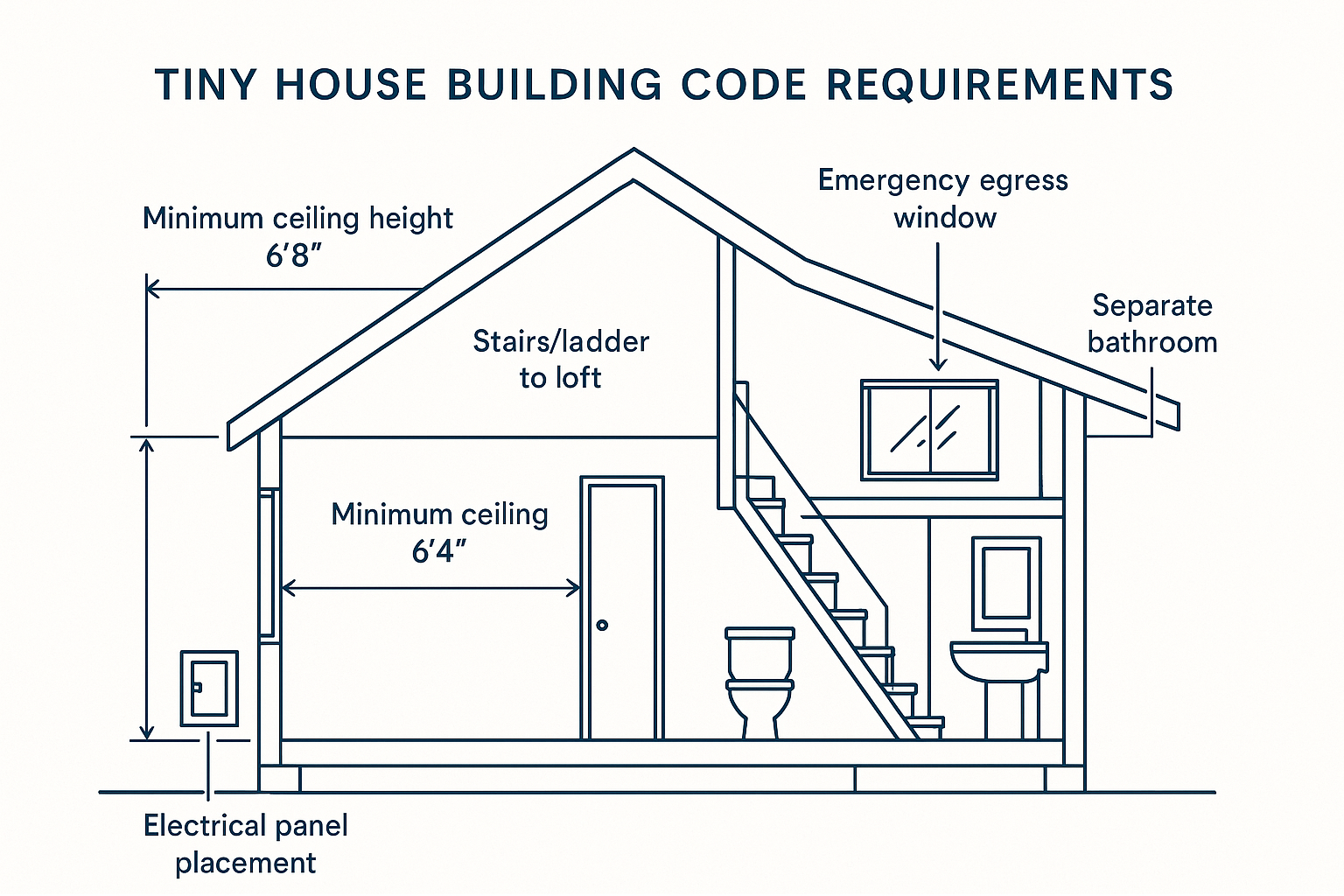
Figure 2: Essential building code requirements for tiny houses, including minimum ceiling heights, emergency egress, and structural specifications mandated by the International Residential Code.
Building codes establish the technical requirements for safe construction, covering everything from minimum ceiling heights and emergency egress windows to electrical panel specifications and plumbing configurations. The IRC requires habitable spaces in tiny houses to maintain a minimum ceiling height of 6 feet 8 inches, while bathrooms and kitchens can have reduced heights of 6 feet 4 inches [3]. These standards ensure adequate ventilation, natural light, and emergency access, but they can significantly impact interior design choices and overall livability in ultra-compact spaces. For those planning to extend their tiny house to maximize comfort, understanding these height restrictions is crucial for creating functional loft spaces and multi-level designs.
Zoning regulations represent perhaps the most significant hurdle for tiny house placement, as these local laws determine where different types of housing can be located within a community. Traditional zoning codes often include minimum square footage requirements for primary residences, typically ranging from 600 to 1,200 square feet, effectively excluding tiny houses from many residential areas. However, the growing recognition of housing affordability challenges has prompted many jurisdictions to create specific zoning categories for tiny houses or to allow them as accessory dwelling units (ADUs) on existing residential properties.
State-by-State Legal Analysis: Where Tiny Houses Are Welcome
States with Favorable Tiny House Laws
California stands out as one of the most progressive states for tiny house development, with multiple pathways for legal tiny house living. The state allows tiny houses as ADUs in most jurisdictions, provided they meet specific requirements including a minimum ceiling height of 7 feet 6 inches and proper utility connections [4]. Fresno made history as the first U.S. city to officially recognize tiny houses on wheels as secondary living units, creating a regulatory framework that other California cities have since adopted. The state’s approach emphasizes safety and habitability while providing flexibility for innovative housing solutions that complement traditional tiny house curb appeal features.
Texas offers a particularly welcoming environment for tiny house enthusiasts, with no statewide prohibition on tiny house construction and several cities actively promoting tiny house development. Austin’s recent HOME Initiative represents a landmark policy shift, reducing minimum lot sizes to 2,500 square feet and allowing up to three units on single-family properties, including tiny houses classified as ADUs [5]. The city of Spur gained national attention by becoming the first American municipality to eliminate minimum size requirements for residential structures, creating an ideal environment for tiny house communities. This progressive approach makes Texas an excellent choice for those considering why tiny houses make great vacation homes.

Figure 3: Different zoning scenarios and placement options for tiny houses, from ADU placement to planned communities and rural settings.
Colorado has emerged as a leader in tiny house regulation following the passage of House Bill 1242 in 2022, which recognized tiny homes as legitimate housing options amid rising home costs. The state’s new administrative rules, effective January 1, 2025, place tiny homes on the same regulatory foundation as other manufactured housing, enabling long-term occupancy and financing options previously unavailable [6]. This comprehensive approach addresses many of the legal uncertainties that have historically plagued tiny house owners and provides a model for other states considering similar legislation.
Maine maintains relatively lenient regulations for tiny houses, defining any structure under 400 square feet as a tiny home and allowing considerable flexibility in placement and construction standards. The state’s rural character and emphasis on self-sufficiency align well with tiny house principles, making it an attractive destination for those seeking off-grid living opportunities. Local jurisdictions generally support tiny house development as a solution to housing affordability challenges, particularly in coastal areas where traditional housing costs have become prohibitive for many residents.
States with Restrictive or Prohibited Tiny House Laws
Eight states currently maintain explicit prohibitions or severely restrictive regulations that effectively ban tiny house living: Alaska, Iowa, Louisiana, North Dakota, New Jersey, New York, Wisconsin, and West Virginia [7]. These restrictions typically stem from concerns about housing quality, public safety, and property values, though advocacy groups continue to push for legislative changes that would allow regulated tiny house development.
New York presents particular challenges for tiny house enthusiasts, with strict building codes and zoning regulations that make legal tiny house placement extremely difficult. The state’s emphasis on high-density development and stringent safety standards creates barriers for alternative housing models, though some rural counties have shown interest in pilot programs for tiny house communities. Recent legislative proposals have sought to create pathways for tiny house development, but progress remains slow due to concerns about infrastructure capacity and regulatory oversight.
New Jersey maintains some of the most restrictive housing regulations in the nation, with minimum square footage requirements and zoning restrictions that effectively prohibit tiny houses in most areas. The state’s high population density and limited available land contribute to regulatory caution around alternative housing models, though some municipalities have expressed interest in tiny house pilot programs as potential solutions to affordable housing shortages.
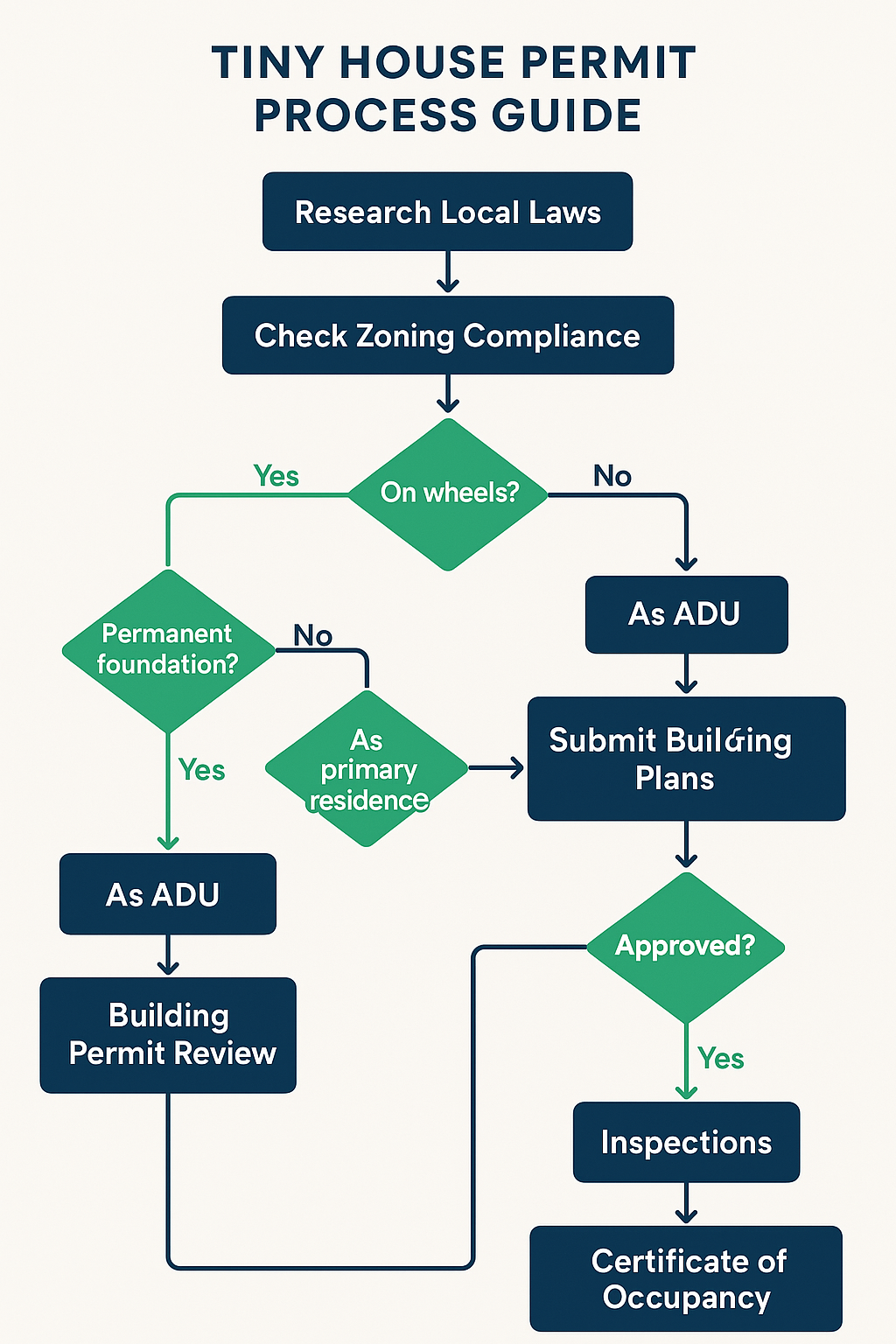
Figure 4: Step-by-step flowchart showing the permit process for tiny houses, including decision points for different foundation types and zoning classifications.
Building Codes and Technical Requirements
Understanding the technical requirements for tiny house construction is essential for ensuring compliance with safety standards and avoiding costly modifications after construction begins. The International Residential Code provides the foundation for most state building codes, but local jurisdictions often impose additional requirements or modifications that can significantly impact design and construction costs.
Structural Requirements for tiny houses must address the unique challenges of compact living while maintaining safety standards equivalent to traditional homes. Foundation systems vary dramatically between tiny houses on wheels and permanent foundation structures, with each approach requiring different engineering considerations and regulatory approvals. Tiny houses on permanent foundations must comply with standard residential foundation requirements, including proper footings, moisture barriers, and frost protection appropriate to local climate conditions.
For tiny houses on wheels, the structural system must accommodate both the static loads of normal occupancy and the dynamic forces encountered during transportation. This dual-purpose design requirement often necessitates over-engineering compared to stationary structures, increasing both material costs and construction complexity. The trailer frame must be properly sized and engineered to support the structure, with appropriate tie-down systems and weight distribution to ensure safe transportation and stable placement. Those interested in maximizing vertical space should explore double-loft designs while ensuring compliance with height restrictions.
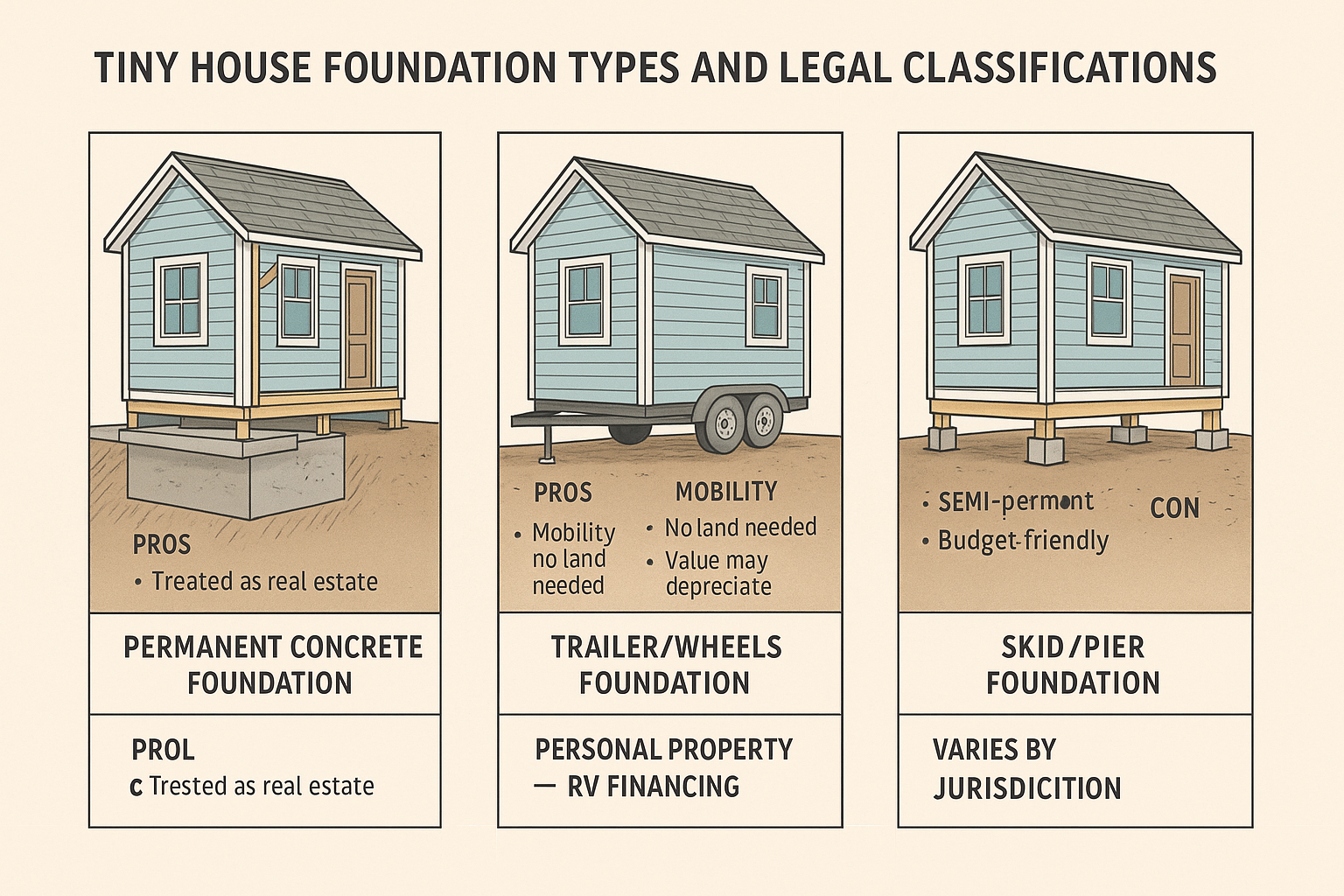
Figure 5: Comparison of different tiny house foundation types and their legal classifications, from permanent concrete foundations to trailer-based systems.
Electrical Systems in tiny houses must meet the same safety standards as traditional homes while accommodating the space constraints and unique power requirements of compact living. The National Electrical Code (NEC) applies to tiny house electrical installations, requiring proper grounding, circuit protection, and outlet placement to ensure safe operation. Many tiny houses incorporate renewable energy systems such as solar panels and battery storage, which must be properly integrated with conventional electrical systems and comply with local utility interconnection requirements.
The electrical panel in a tiny house must be appropriately sized for the anticipated electrical load while remaining accessible for maintenance and inspection. Ground fault circuit interrupter (GFCI) protection is required in bathrooms, kitchens, and outdoor areas, just as in traditional homes. The compact nature of tiny houses often requires creative solutions for electrical routing and component placement while maintaining code compliance and accessibility, particularly when creating compact home office setups that require dedicated electrical circuits.
Plumbing and Water Systems present unique challenges in tiny house design, as standard plumbing codes must be adapted to extremely compact spaces while maintaining functionality and safety. The IRC requires at least one separate bathroom in tiny houses, with proper ventilation and drainage systems [8]. Water supply systems must provide adequate pressure and flow for all fixtures, which can be challenging in tiny houses with limited space for conventional plumbing runs.
Waste management systems vary significantly depending on whether the tiny house connects to municipal utilities or operates with self-contained systems. Tiny houses connected to municipal sewer systems must comply with standard plumbing codes for drainage and venting, while off-grid systems may utilize composting toilets, greywater recycling, or other alternative waste management approaches that require specific approvals and ongoing maintenance.
Zoning Challenges and Solutions
Zoning regulations represent the most significant barrier to tiny house placement in many jurisdictions, as traditional zoning codes were developed around conventional housing models and often include provisions that inadvertently exclude tiny houses. Minimum square footage requirements, setback regulations, and density restrictions can make it impossible to legally place tiny houses in many residential areas, forcing owners to seek creative solutions or alternative locations.
Accessory Dwelling Unit (ADU) Regulations have emerged as one of the most promising pathways for legal tiny house placement, as many jurisdictions allow small secondary structures on existing residential properties. ADU regulations typically specify maximum size limits, occupancy restrictions, and design standards that can accommodate tiny houses while addressing community concerns about density and character. However, ADU regulations vary dramatically between jurisdictions, with some allowing detached structures while others require attachment to the primary residence.
The process of obtaining ADU approval often involves design review, neighbor notification, and compliance with parking requirements that can add significant time and cost to tiny house projects. Some jurisdictions require owner occupancy of either the primary residence or the ADU, limiting rental opportunities and investment potential. Understanding local ADU regulations is essential for anyone considering tiny house placement on existing residential property, particularly when exploring options in states with comprehensive tiny home directories.
Planned Unit Developments (PUDs) and tiny house communities represent another approach to addressing zoning challenges through comprehensive planning and community design. These developments allow for flexible zoning arrangements that can accommodate tiny houses while maintaining overall community standards and infrastructure requirements. Successful tiny house communities often incorporate shared amenities, common spaces, and sustainable infrastructure that enhance livability while reducing individual unit costs.
The development of tiny house communities requires significant upfront planning and regulatory approval, but can provide economies of scale for infrastructure development and ongoing maintenance. Community-based approaches also address some of the social isolation concerns associated with tiny house living while creating supportive environments for sustainable living practices.
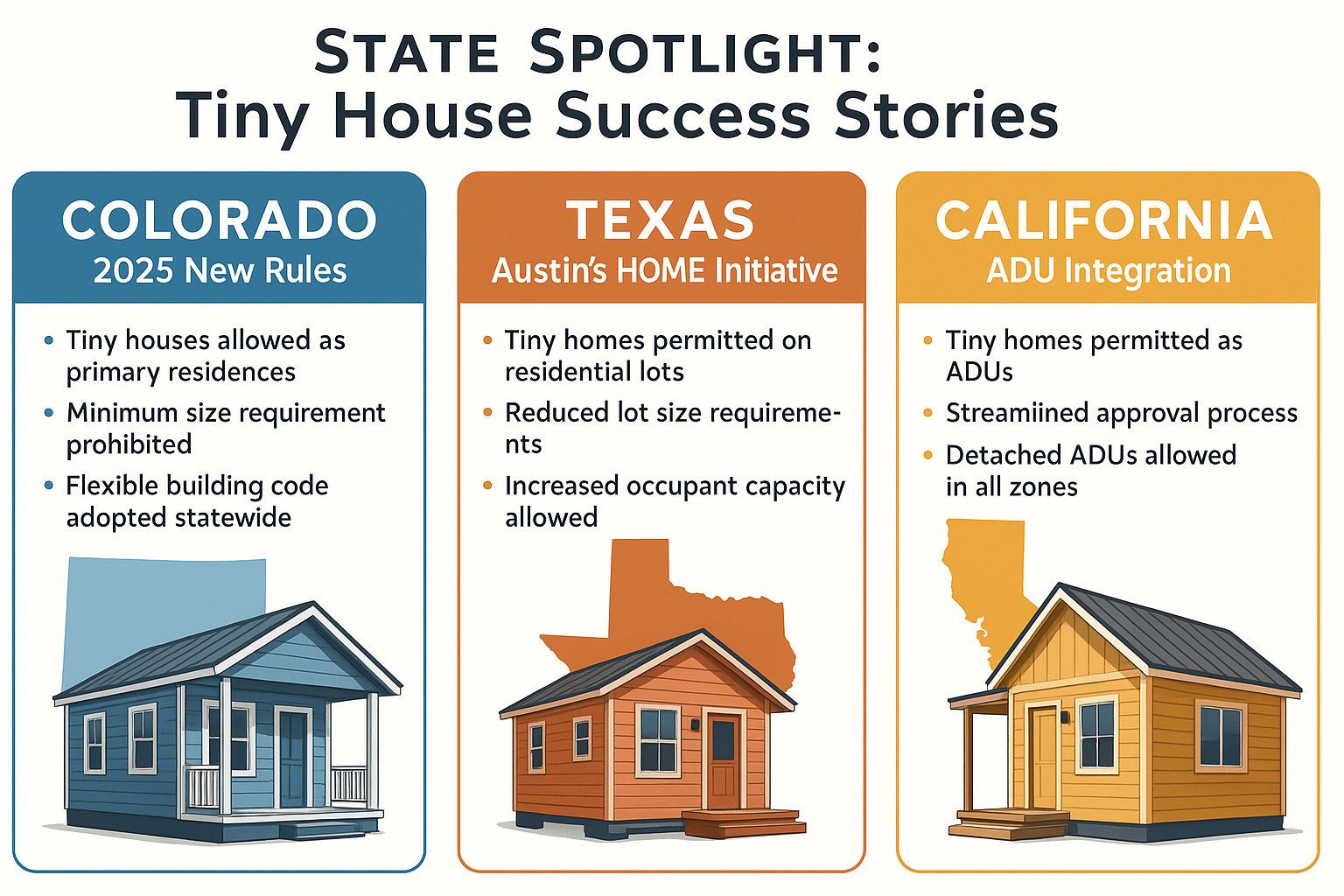
Figure 6: Success stories from Colorado, Texas, and California showcasing progressive tiny house policies and their implementation at the state level.
Recent Legislative Developments and Trends
The regulatory landscape for tiny houses continues to evolve rapidly as states and local jurisdictions respond to housing affordability challenges and changing lifestyle preferences. Recent legislative developments demonstrate growing recognition of tiny houses as legitimate housing solutions, though the pace and scope of regulatory change varies significantly across different regions.
Colorado’s Comprehensive Approach represents one of the most significant regulatory developments in recent years, with the state’s new administrative rules effective January 1, 2025, providing a comprehensive framework for tiny house regulation [9]. The legislation recognizes tiny homes as manufactured housing, enabling access to traditional financing and insurance options while establishing clear safety and quality standards. This approach addresses many of the legal uncertainties that have historically limited tiny house adoption and provides a potential model for other states.
The Colorado framework distinguishes between tiny houses and tiny homes, with tiny homes defined as factory-built structures subject to state oversight and tiny houses referring to site-built structures regulated under local building codes. This distinction provides clarity for builders, buyers, and regulators while ensuring appropriate oversight for different construction methods and quality standards.
Texas Legislative Initiatives continue to expand opportunities for tiny house development, with recent legislation allowing smaller homes on smaller lots in major cities and Austin’s HOME Initiative creating new pathways for ADU development [10]. The state’s approach emphasizes local control while removing regulatory barriers that have historically limited housing diversity and affordability.
The Texas model demonstrates how state-level policy changes can enable local innovation while maintaining appropriate safety and quality standards. By reducing minimum lot sizes and allowing multiple units on single-family properties, the state has created opportunities for tiny house development that were previously impossible under traditional zoning frameworks.
Financing and Insurance Considerations
The legal classification of tiny houses significantly impacts financing and insurance options, with many traditional lenders and insurers reluctant to provide coverage for structures that don’t fit conventional housing categories. Understanding these financial implications is essential for anyone considering tiny house ownership, as the availability and cost of financing and insurance can dramatically affect the overall economics of tiny house living.
Financing Challenges for tiny houses stem primarily from their classification as either personal property or real estate, depending on whether they’re built on wheels or permanent foundations. Tiny houses on wheels are typically classified as personal property, similar to RVs or mobile homes, making them ineligible for traditional mortgage financing. This classification often requires buyers to seek personal loans, RV financing, or alternative lending arrangements that may carry higher interest rates and shorter repayment terms.
Tiny houses on permanent foundations may qualify for traditional mortgage financing if they meet minimum square footage requirements and comply with local building codes. However, many lenders remain cautious about tiny house financing due to concerns about resale value and market acceptance. The development of specialized tiny house lenders and financing programs has begun to address these challenges, but options remain limited compared to traditional housing finance.
Insurance Considerations for tiny houses require careful evaluation of coverage needs and available options, as standard homeowners insurance may not provide adequate protection for tiny house owners. Tiny houses on wheels may require RV insurance or specialized tiny house insurance policies that address the unique risks associated with mobile structures. Coverage considerations include protection during transportation, liability for visitors, and replacement cost coverage that reflects the custom nature of many tiny house builds.
The location and use of tiny houses also affects insurance requirements and availability, with some insurers requiring permanent placement and utility connections for coverage. Off-grid tiny houses may face additional challenges in obtaining insurance coverage, particularly for alternative energy systems and water management infrastructure that may not be covered under standard policies.
Future Outlook and Recommendations
The future of tiny house regulation appears increasingly positive as more states and local jurisdictions recognize the potential benefits of alternative housing models in addressing affordability and sustainability challenges. However, the regulatory environment will likely remain complex and varied, requiring careful research and planning for anyone considering tiny house living.
Emerging Trends in tiny house regulation include greater integration with ADU policies, recognition of tiny houses as manufactured housing, and development of specialized zoning categories that accommodate alternative housing models. The success of early adopter states like Colorado and progressive cities like Austin provides models for other jurisdictions considering regulatory reforms.
The increasing focus on housing affordability and climate change mitigation is likely to drive continued interest in tiny houses and other alternative housing models. As more jurisdictions gain experience with tiny house regulation and development, best practices will emerge that balance innovation with safety and community concerns.
Recommendations for Prospective Tiny House Owners include thorough research of local regulations before beginning any tiny house project, consultation with local building officials and planning departments to understand specific requirements, and consideration of long-term goals for tiny house placement and use. Working with experienced tiny house builders and consultants can help navigate regulatory challenges and ensure compliance with applicable codes and standards.
The importance of community engagement and education cannot be overstated, as public support for tiny house development often depends on addressing concerns about safety, property values, and community character. Successful tiny house projects typically involve extensive outreach and collaboration with neighbors, local officials, and community organizations to build support and address potential concerns.
Conclusion
Navigating tiny house laws by state requires careful research, planning, and often creative problem-solving to achieve legal compliance while realizing the benefits of tiny house living. The regulatory landscape continues to evolve rapidly, with increasing recognition of tiny houses as legitimate housing solutions balanced against ongoing concerns about safety, quality, and community impact.
Success in tiny house development depends on understanding the complex interplay between building codes, zoning regulations, and local ordinances that govern where and how tiny houses can be built and occupied. While challenges remain significant in many jurisdictions, the growing number of success stories and regulatory innovations provides hope for continued expansion of tiny house opportunities.
The key to successful tiny house living lies in thorough preparation, regulatory compliance, and community engagement that addresses concerns while demonstrating the benefits of alternative housing models. As the movement continues to mature and gain mainstream acceptance, the regulatory environment will likely become more standardized and accessible, making tiny house living a viable option for more Americans seeking affordable, sustainable housing solutions.
For those considering tiny house living, the investment in understanding and complying with applicable laws and regulations is essential for long-term success and enjoyment of the tiny house lifestyle. While the regulatory landscape may seem daunting, the growing community of tiny house enthusiasts, builders, and advocates provides valuable resources and support for navigating these challenges successfully. Whether you’re interested in making tiny house living rooms comfortable or exploring rustic farmhouse tiny home decor, understanding the legal framework is the foundation for turning your tiny house dreams into reality.
References
[1] World Population Review. (2025). Tiny House Laws by State 2025. Retrieved from https://worldpopulationreview.com/state-rankings/tiny-house-laws-by-state
[2] Tiny House Alliance USA. (2024). Appendix BB Tiny Houses Inclusive In 2024 IRC. Retrieved from https://www.tinyhouseallianceusa.org/appendix-bb-tiny-houses-inclusive-in-2024-irc/
[3] Tiny Society. (2024). Tiny House Laws in the United States. Retrieved from https://www.tinysociety.co/articles/tiny-house-laws-united-states/
[4] California Department of Housing and Community Development. (2025). California’s Tiny Home Rules and Regulations. Retrieved from https://www.tinyhouse.com/post/californias-tiny-home-rules-and-regulations
[5] City of Austin. (2025). HOME Amendments. Retrieved from https://www.austintexas.gov/page/home-amendments
[6] Colorado Division of Housing. (2025). Laws, Rules, and Policies – Tiny Homes and Tiny Houses. Retrieved from https://doh.colorado.gov/laws-rules-and-policies-tiny-homes
[7] World Population Review. (2025). Tiny House Laws by State 2025. Retrieved from https://worldpopulationreview.com/state-rankings/tiny-house-laws-by-state
[8] International Code Council. (2018). Appendix Q Tiny Houses. Retrieved from https://codes.iccsafe.org/content/IRC2018/appendix-q-tiny-houses
[9] Colorado Division of Housing. (2025). Administrative Rules. Retrieved from https://doh.colorado.gov/laws-rules-and-policies-tiny-homes
[10] Texas Tribune. (2025). Texas House OKs bill to allow homes on smaller lots. Retrieved from

